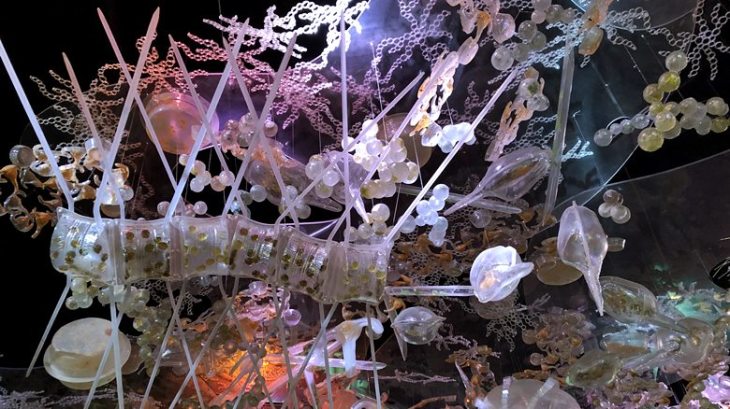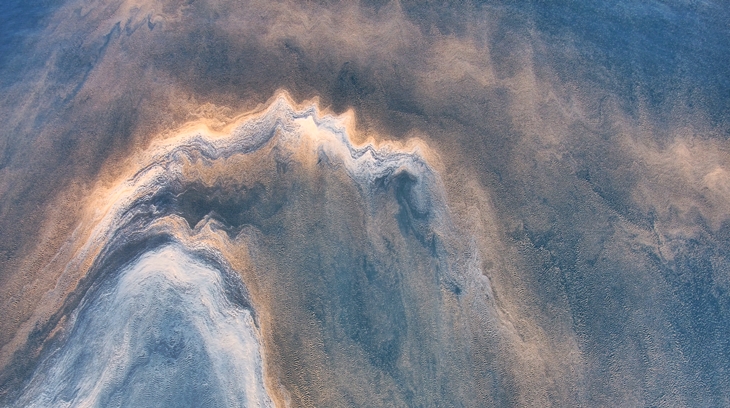Plankton in the Tidal Current
It is generally known that ebb and flow shape the face of the North Sea. How heavily the tides influence the growth of algae - primary production - has still, however, barely been studied. Because primary production is the basis of all life in the sea, scientists from the Institute of Coastal Research at the Helmholtz-Zentrum Geesthacht (HZG) have looked more closely at the tidal influence with the help of model calculations – and in doing so, they have made some astounding discoveries.

Made visible to the eye: image of a plankton cloud at the OZEANEUM Stralsund (Photo: Sabine Billerbeck / HZG)
Life in the sea begins with microscopically small algae, with phytoplankton. Like plants on land, they use sunlight to produce sugar, which is then converted into other compounds. This is what is called primary production and is the foundation of the entire food chain in the sea. The algae then nourish the zooplankton (smallest crabs, fish or mussel larvae), which in turn serve as food for higher animals.
Due to their fundamental role, the scientists have been studying primary production and the growth of phytoplankton in marine regions around world for many years - this also includes the North Sea. The problem is that taking measurements is arduous, as ship expeditions are required to collect samples. Chlorophyll concentrations in surface seawater can in fact be measured by satellite today and algae growth can thus be inferred. These snapshots, however, only provide a portion of the overall picture.
Tidal Currents in the Computer Model
If we want to understand why phytoplankton is sometimes present in greater or smaller quantities in certain marine regions, we need to know more - for example, the volume of nutrients available in the water. Or how clear the water is so that enough light can penetrate, which is required for algal growth.
The oceanographer Dr Changjin Zhao together with Prof Corinna Schrum and Dr Ute Daewel at the HZG’s Institute of Coastal Research have now extensively studied for the first time the influence of an additional parameter that also heavily influences primary production: the tidal currents. “There are individual studies from the North Sea, such as from the Dogger Bank in the central North Sea, but they were always selective studies,” says Changjin Zhao. “We have now taken a closer look at the tides across the entire North Sea for the first time.”
This work was undertaken using mathematical model calculations, employing the ECOSMO model (ECOSystem model). This model is able to combine physical aspects such as currents or temperatures with biochemical parameters - for example, consumption or production of nutrients through biological and chemical processes in the water and in the sediment.

Rising water in a tidal channel during the change of tides (Photo: Ina Frings)
Thanks to this analysis that spans the entire North Sea, the scientists made some new discoveries. They have, for example, discovered that the North Sea can be roughly divided into three regions in terms of tidal influence.
In the flat southern regions of the North Sea, the tides heavily mix the water body. In doing so, the phytoplankton is again and again carried from the water’s surface into the dark deeper water layers. The sediment is stirred up in addition. This makes less light available to the algae, and the photosynthetic capacity and primary production are therefore reduced here more than in a system without tides.
In total, the tides in North Sea regions close to the coast can therefore lead to a reduction in primary production. “In order to come to such conclusions, we had ECOSMO perform a calculation once with tides and once without. In comparison, the tidal influence then becomes clear“, says Changjin Zhao.
Nutrient Replenishment in Frontal Regions
There is normally more stable stratification in the water masses of the deeper North Sea during the phytoplankton production phase in spring and summer. Warm water with less density lies atop a water body consisting of cold water with a higher density.
ECOSMO provided interesting results for the region where the zone with stratified water and the more heavily mixed water masses of the southern North Sea meet. This region is termed a frontal region. For these fronts, the model data show that the tides increase the amount of nutrients carried into the upper, warmer water layer. This is positive because the nutrients in the surface water are quickly consumed in spring. When it becomes warmer and the sun shines longer, plankton grows extensively, which is called a bloom.
Just as in a balcony flower pot that isn’t fertilized, the plant nutrients dissolved in the water are quickly depleted. The tide supplies replenishments from the depths in frontal regions.

Aerial photo of an algal bloom in the North Sea (Foto: Sabine Billerbeck)
The situation is different in the third region identified by ECOSMO: the northern North Sea. Here the water is deeper and even more heavily stratified so that the tidal influence and the supply of nutrients are very low.
Nutrient Fluxes Modelled in Detail
ECOSMO models the processes in the sea in astounding detail. The absorption of nutrients by the phytoplankton is thus comprehensively simulated. In addition, the influence of zooplankton comes into play. The zooplankton eat the algae and excrete faeces, thereby releasing nutrients back into the water.
This is how the tidal analysis also provided interesting detailed results. The researchers determined, for example, that the spring blooms - particularly off Scotland and northern England - are delayed by the tide, which is apparently connected to delayed stratification of the water masses in spring.
The tide swirls the water more heavily so that in spring the formation of clear water layers is disturbed and delayed. Only with increasing temperatures is the density difference between the upper and lower water masses so large that they form layers. This stratification is, however, necessary, so that the phytoplankton stay in the areas flooded with light near the water’s surface and can reproduce. Because the stratification is delayed, phytoplankton growth is initially slowed and, along with it, primary production. Ultimately, the onset of the phytoplankton blooms is delayed; but it will then be stronger than in other North Sea regions.

Zooplankton is dependent on the primary production of phytoplankton (Photo: Klas Ove Möller / HZG)
Influence of the Springtide
The HZG scientists also reviewed the extent to which spring and neap tides influence the primary production in the North Sea. Spring and neap tides follow moon phases.
The tidal current is particularly strong during spring tide at full moon and new moon. In contrast, the current at half moon during neap tide is especially weak. One result is that the spring tide in particular may very well assert an influence on primary production - and in doing so, the effects could even be very different in directly neighbouring marine regions.
The modelling shows, for example, that primary production in the Humber estuary on the eastern coast of England decreases immediately after spring tide. In the western area of the nearby Dogger Bank, on the other hand, primary production increases with the spring tide, an effect that was unknown until now.
Zhao has a plausible explanation for this: “In the relatively flat Humber estuary, the strong spring tidal current causes more heavy mixing of the water masses. The water is clouded by the swirling sediments so that less light is available to the algae.” On the western Dogger Bank, on the other hand, the water is more heavily stratified. Here the prevailing effect is that the spring tide transports the nutrients from the depths upwards..
Better Understanding the North Sea System
The work of Changjin Zhao, Corinna Schrum and Ute Daewel contributes to the better understanding of the “North Sea as a whole" - the differing influences controlling primary production. “This is a requirement for better estimating the influence of climate change in the future,” says Daewel. By researching the effects of tides, the scientists have now thoroughly elucidated a major natural influencing factor for the first time.
(Text: Tim Schröder, Science Journalist / English Translation: Anupa Srinivasan)

